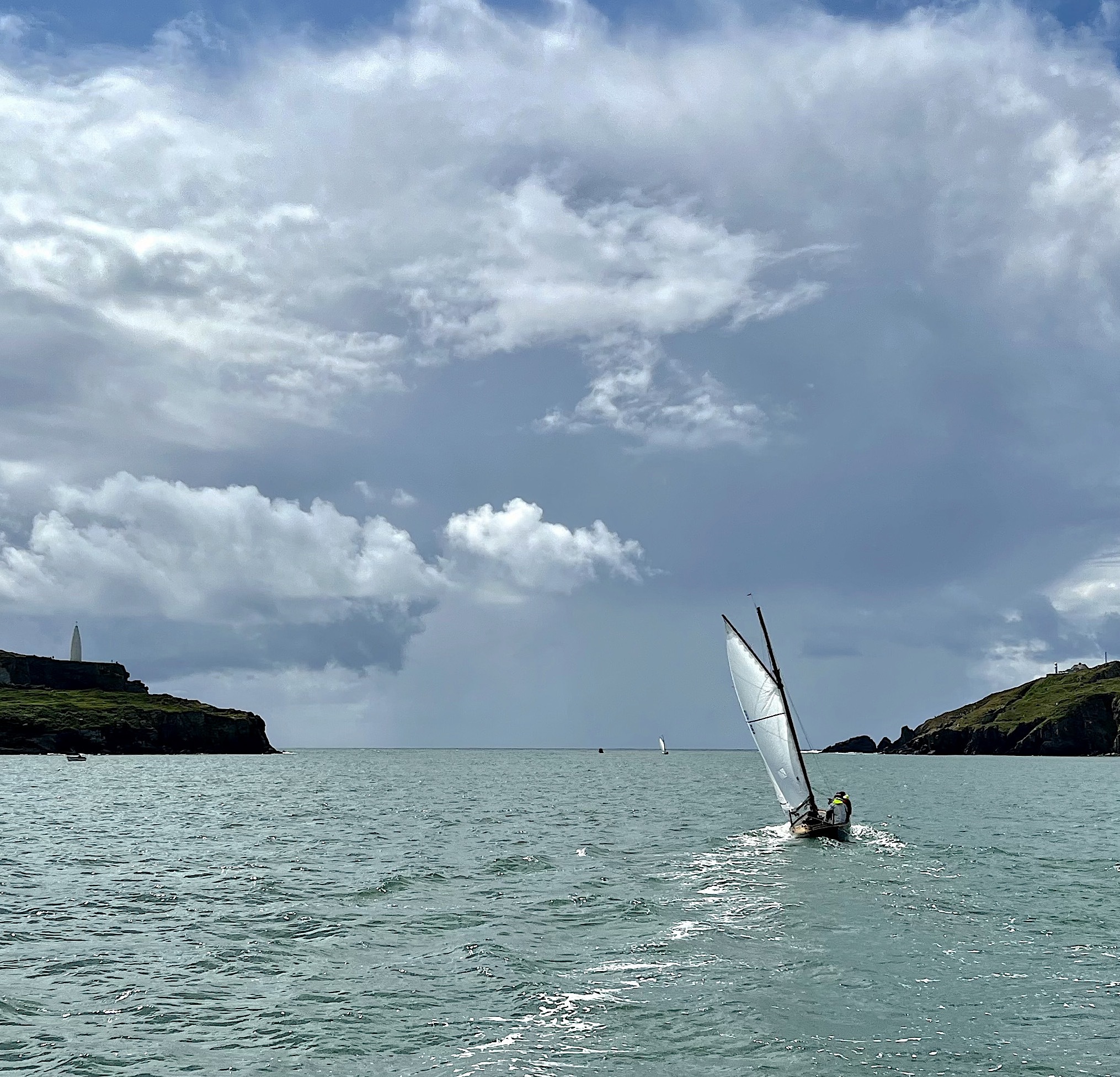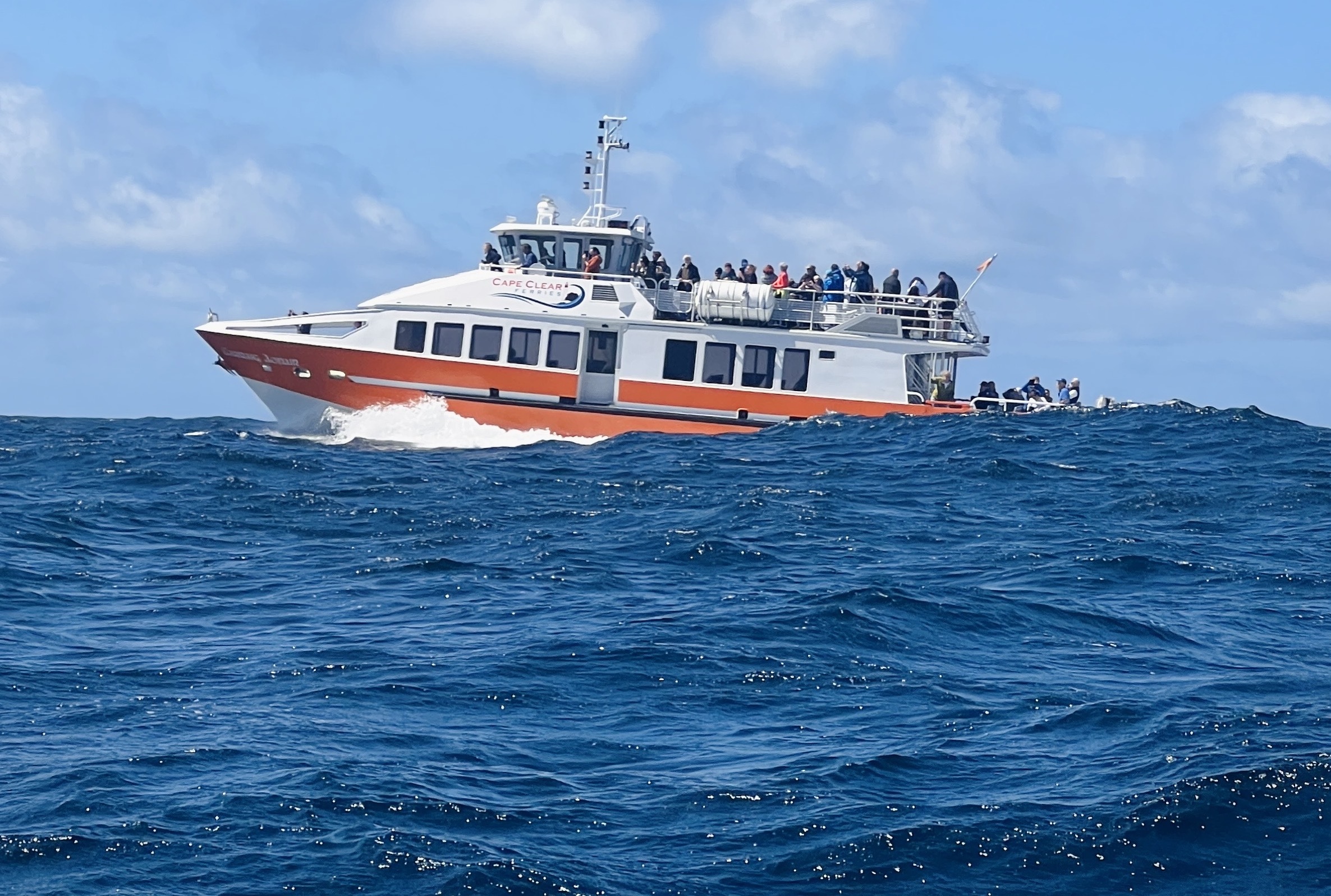Howth 17s Return From West Cork After a Historic Trip
02 July 2023
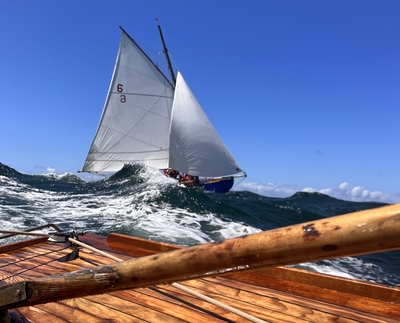
Last Sunday in West Cork, a dozen crews from Howth had been limbering up for a week of sailing among Carbury’s Hundred Isles in boats which are themselves time capsules, as the design of the Howth 17 has remained unchanged for more than a century. On the 20th anniversary of their last visit to West Cork, the Howth 17s travelled to Baltimore as part of their season-long celebrations for the 125th year of their class. (Top pic Karolina Badz)
The very active class is credited with being the oldest one-design racing keelboat in the world and is still built and rigged as originally designed by Walter Herbert Boyd in 1897.
Thus the most senior of the 12 boats that have been road-trailed to West Cork for a highlight of their 125th birthday year were already six years old when the emblematic Fastnet Rock lighthouse started operating in 1904.
The energetic Class Captain David O’Shea along with a specially appointed committee had devised a programme that would include a circuit of the Fastnet Rock on Wednesday. It’s a return visit for some, as three of the boats were there twenty years ago when they took a westward expansion from their participation in the Glandore Classics Regatta of 2003.
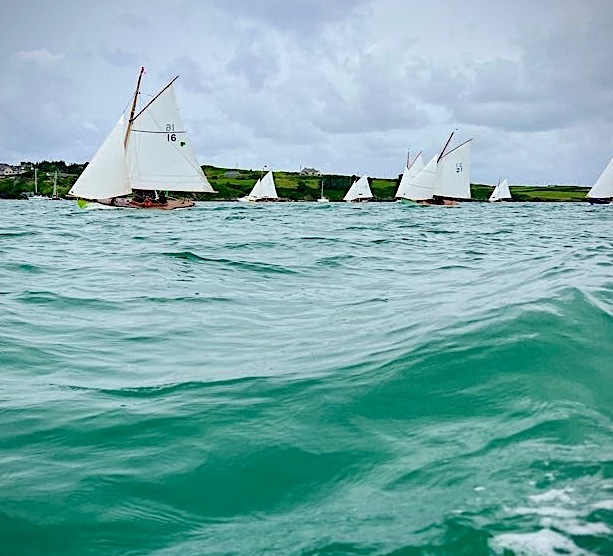 This time round, Baltimore was to be their most easterly port, while Crookhaven was to be furthest west, the programme being: Baltimore-Schull on Monday, Schull to Crookhaven on Tuesday, Crookhaven to Fastnet Rock and North Harbour Cape Clear on Wednesday, integrating options to enjoy Sherkin Island on the way to rounding out the celebrations with a plan for some serious racing off Baltimore on Friday.
This time round, Baltimore was to be their most easterly port, while Crookhaven was to be furthest west, the programme being: Baltimore-Schull on Monday, Schull to Crookhaven on Tuesday, Crookhaven to Fastnet Rock and North Harbour Cape Clear on Wednesday, integrating options to enjoy Sherkin Island on the way to rounding out the celebrations with a plan for some serious racing off Baltimore on Friday.
Regular road trailing was completely unknown when the Howth Seventeens first sailed, but despite the rigging complexity their crews had shown themselves sufficiently enthusiastic to undertake the hassle in order to provide the best of sailing sport in a very special setting. In recent years, many of the owners have invested in their own road trailers, affording options to create and participate in events beyond the confines of a small day-sailing racing keelboat.
Anyone familiar with the class will know there will be no shortage of stories from any events and trips they make, and this ‘rally’ would be no different. Even before the boats arrived at their destination, the adventure began and coincided with the change to more usual summer weather.
Not used to navigating on land, the newest-built boat within the class ‘Orla’ (2017), took an early but erroneous decision to choose the port tack to the M7 towards Limerick - a tactic that might be better suited at sea, with the forecast of a veering, fresh wind from the west. The recent warm and benign weather conditions were forecasted to end this week, and the Howth 17s greeted the news with relish rather than dread, setting out fully crewed but sensibly without their distinctive topsails, towards the Atlantic seas for their ‘acclimatisation’ day on
Sunday. This was to be an important excursion for many, finding their sea legs in time for the days ahead.
Some took the opportunity to anchor off Sherkin Island, where crew went swimming, while other teams tested the conditions and the long ocean swell following days of new westerly wind below the developing low-pressure system in the North Atlantic. The historic fleet hadn’t encountered such a sea state in 20 years, and when they previously travelled to Glandore in 2003 for their Championships.
It was also a perfect day to circumnavigate Sherkin Island, passing through Gascanane Sound and viewingRoaringwater Bay towards Schull (Monday’s destination) before negotiating the narrows of the ‘back passage’ downwind between Heir Island and Sherkin Island. The six boats that chose to take this route needed to take precautions for what is a tricky undertaking in a non-engined keelboat, not least for those that hadn’t upgraded their iPhone marine-chart apps to the ‘paid’ versions.
More used to the younger members of Howth Yacht Club that make the regular journey to train and race in front of the harbour, Baltimore Sailing Club and Commodore Grahame Copplestone welcomed the crews to the club after their first day’s sail with a special BBQ for the Howth 17 crews on Sunday evening. Afterwards, the ever-energetic class members filled Bushe’s Bar and other local hostelries with scenes that would be repeated daily for some days to come.
The frequently misquoted ‘if you build it, he will come’ is often used to inspire and motivate people to follow their instincts in respect of unthinkable events and dreams, but it seemed like destiny for the oldest one-design racing keelboat class in the world, this week. Because after months of fickle and light winds and then a forecast of the return to normal Irish weather, most sailors should baulk at the thought of relocating their prize assets to distant shores, not least in the direction of the oncoming wind. Not so for the Howth 17s, who proved with resilience this week that a spirited and convivial bunch can make anything happen when it comes to planning a sailing event.
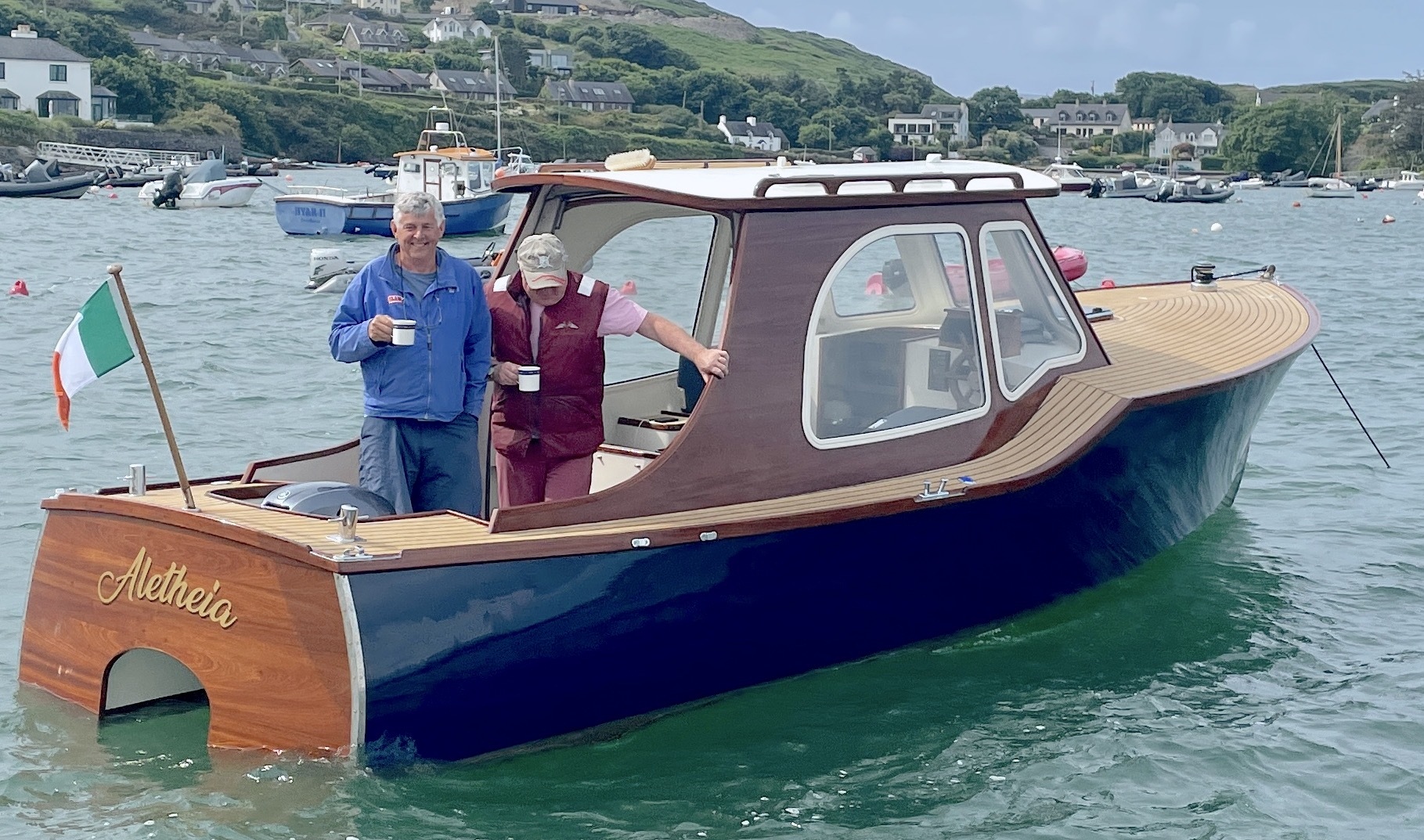 Monday’s sail to Schull was an important first step westward and it comprised of a beat to Gascanane Sound and a long fetch to Schull Harbour with generous support from Judith Malcolm on the HYC RIB, Donal Gallagher on ‘Catalina’ and David Harte with Alan Crosbie on Harty’s fine new Boston Whaler ‘Aletheia’ (built by him during Covid). The 4 hour trip was enjoyed by all, as was the hospitality ashore in Schull afterwards with the team bus to take most home to Baltimore that evening.
Monday’s sail to Schull was an important first step westward and it comprised of a beat to Gascanane Sound and a long fetch to Schull Harbour with generous support from Judith Malcolm on the HYC RIB, Donal Gallagher on ‘Catalina’ and David Harte with Alan Crosbie on Harty’s fine new Boston Whaler ‘Aletheia’ (built by him during Covid). The 4 hour trip was enjoyed by all, as was the hospitality ashore in Schull afterwards with the team bus to take most home to Baltimore that evening.
Tuesday was to be a slightly more challenging sail – Schull to Crookhaven into a strong south westerly. However the grey skies belied what turned out to be a warm afternoon in the gusty conditions, with many of the Howth 17 skippers using the opportunity to train new helms in upwind sailing and the tricky ‘17 tack!’ An extraordinary welcome awaited in the shelter of Crookhaven, with the shore lined with locals as they watched the 17s tacking up the short channel to the moorings. Despite the generous offer from Commodore Gill O’Shea of warm showers at Crookhaven Sailing Club, the hungry and thirsty sailors decide that O’Sullivan’s Bar was too tempting to ignore and another long table was put together for the afternoon.
The 125-year-old keelboat class chose Wednesday as the day to take their 17-foot waterline open keelboats  around the iconic Fastnet Rock, and it couldn’t have been a better decision.
around the iconic Fastnet Rock, and it couldn’t have been a better decision.
 around the iconic Fastnet Rock, and it couldn’t have been a better decision.
around the iconic Fastnet Rock, and it couldn’t have been a better decision.
The morning promised an opening window in the gloomy skies, albeit with the continued very fresh Atlantic winds, and so it was to be. Less than half a dozen of Howth’s legendary class has ever sailed around the 119-year-old lighthouse (built six years after the first Howth 17s). But a lucky few people on boats, including the Cape Clear Ferry, were at the ‘Rock’ on Wednesday afternoon to witness 12 of the famous wooden keelboats rounding it to port after setting out from Crookhaven and then gybe towards the welcome party at the north harbour in Cape Clear.
A steady 23-25 knot north-westerly pressed the boats from Crookhaven to the Fastnet, and the relatively youthful and spinnakered ‘twins’ (Isobel and Erica - 1988) led the fleet around and got to the famous lighthouse first, making the passage in 69 minutes, averaging 6 knots - quite a feat for the normally unhurried classics. Even the support vessels struggled to keep up, including the ever-obliging Judith Malcolm in the specially commissioned HYC RIB, as well as Donal Gallagher’s handsome Beneteau ‘Catalina’, crewed by Alan Markey, Marc Fitzgibbon and Stephanie Gallagher.
But the boats thrived in the conditions, as did the wide-eyed crews and lucky spectators who will all be left with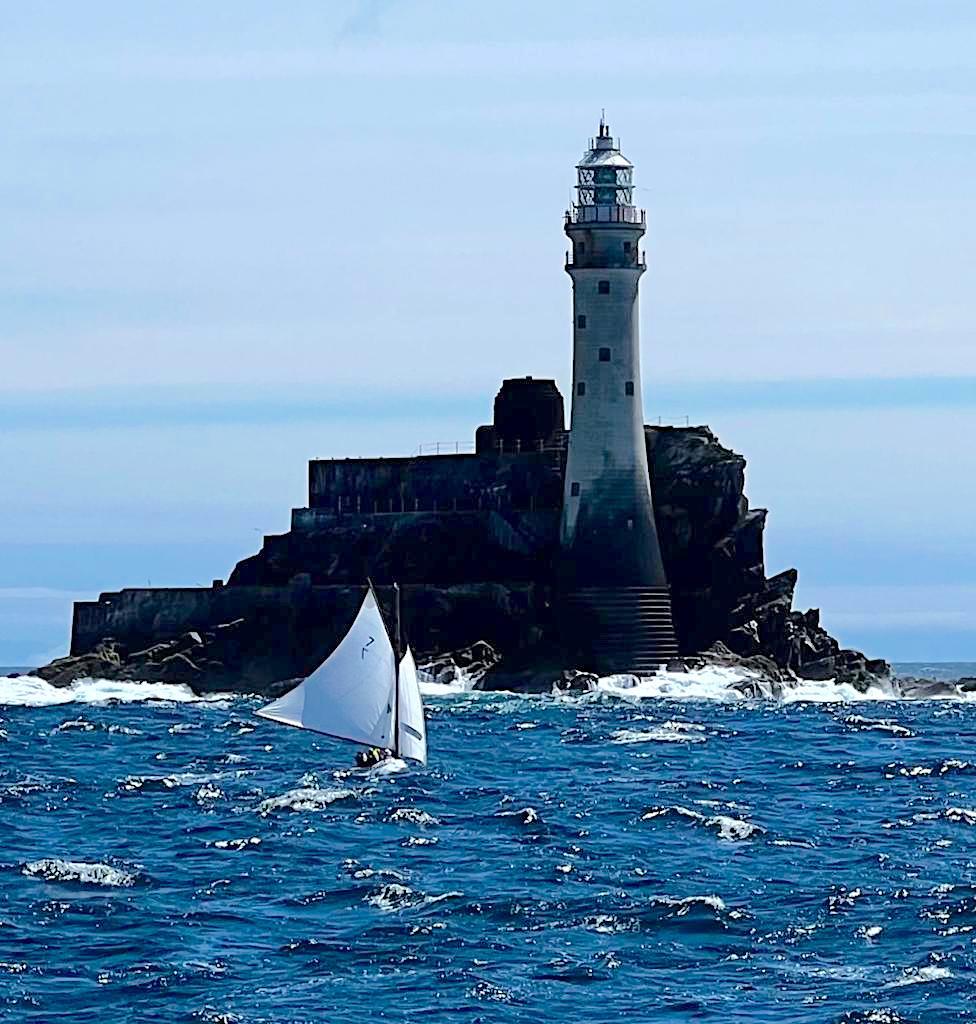 an unforgettable memory, not least aided by the hundreds of photographs, videos and torrent of social media posts that followed even before the boats had docked in the serene surroundings at North Harbour on Cape Clear.The fleet was also joined by a packed Cape Clear Ferry and passengers scrambling to get even more photos that will undoubtedly crop up over the coming years and as SD cards are searched in the future.
an unforgettable memory, not least aided by the hundreds of photographs, videos and torrent of social media posts that followed even before the boats had docked in the serene surroundings at North Harbour on Cape Clear.The fleet was also joined by a packed Cape Clear Ferry and passengers scrambling to get even more photos that will undoubtedly crop up over the coming years and as SD cards are searched in the future.
 an unforgettable memory, not least aided by the hundreds of photographs, videos and torrent of social media posts that followed even before the boats had docked in the serene surroundings at North Harbour on Cape Clear.The fleet was also joined by a packed Cape Clear Ferry and passengers scrambling to get even more photos that will undoubtedly crop up over the coming years and as SD cards are searched in the future.
an unforgettable memory, not least aided by the hundreds of photographs, videos and torrent of social media posts that followed even before the boats had docked in the serene surroundings at North Harbour on Cape Clear.The fleet was also joined by a packed Cape Clear Ferry and passengers scrambling to get even more photos that will undoubtedly crop up over the coming years and as SD cards are searched in the future.
Aided by the blue skies, warm weather and hospitality at Cape Clear (including a BBQ and drinks reception sponsored by Cape Clear Distillery), the 100-plus sailors and visitors enjoyed a relaxing afternoon before half of the fleet sailed back to Baltimore and the other half used the opportunity of a pre-planned ‘layday’ to return to Cape Clear on Thursday.
Indeed, the Thursday trip and sail back was to turn out to be that final trip to sea for Howth’s famous keelboats,
because the rain and wind on Friday inspired the organising team to get the mobile crane back to Baltimore that afternoon, for an effortless lift-out and in plenty of time for some afternoon libations in Bushe’s as a prequel to the final night dinner in Baltimore Sailing Club, hosted by Commodore Grahame Copplestone and Sailing Secretary Rob O’Leary.
The swift lift-out on Friday afforded everyone the opportunity to take as much time as needed on Saturday, allowing Ireland’s main motorway arteries more freedom and a well-spread fleet to return at different times during the day.
Sincere thanks to all who made the week possible, including but not exclusively: sponsors BKS, Lavelle Partners, Cape Clear Distillery as well as the significant contribution from Baltimore Sailing Club, Schull and Crookhaven Harbours, Judith Malcolm, Rob O’Leary, David Harte, Brian Murphy Crane Hire, Malachy Harkin, Luke Massey, Class Captain David O’Shea and everyone else that made it happen.
Registered in the Republic of Ireland. Registered No. 81187
© Howth Yacht Club clg 2025 | web design & seo company - Isobar

